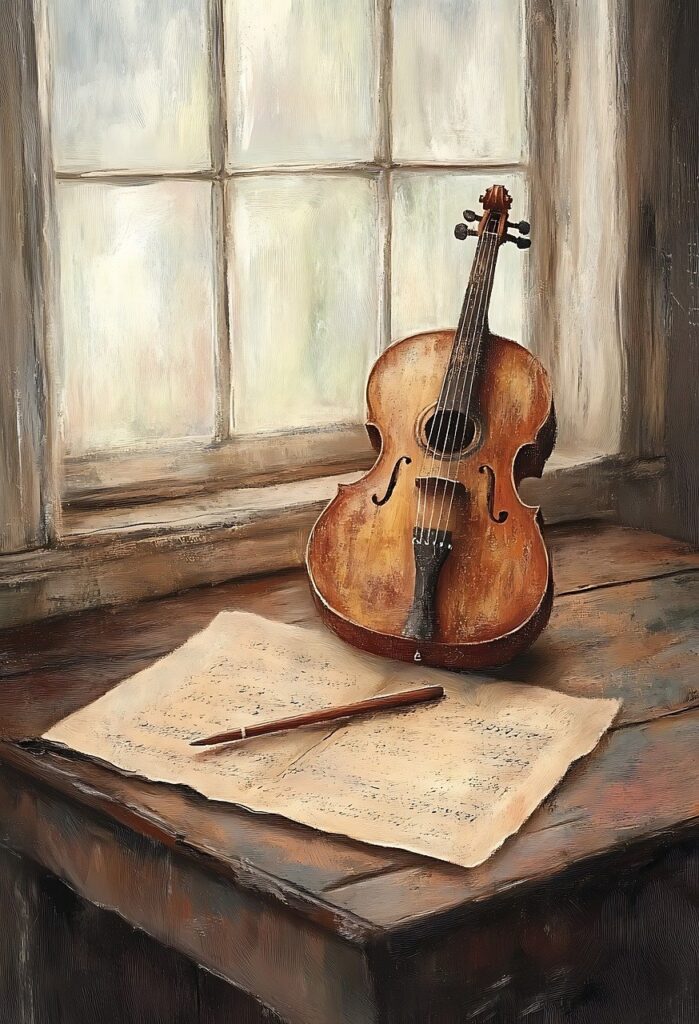The violin is a complex instrument that has been used to play some of the most beautiful pieces in the history of music. It adds emotional depth to a music piece and is not limited to one genre. You don’t have to be at a specific age to learn how to play the violin. It’s open to all of those who have interest in learning it, no matter how young or old.
Playing the violin can help you improve your motor and cognitive functions and also offer mental health benefits like stress relief.
Equipment needed:
- Violin
- Bow
- Chin rest
- Shoulder rest
- Rosin
- Violin case
1. When learning the violin, the things you need are not only the bow and instrument itself. You need to buy rosin, chin rest, shoulder rest, and a case for your violin. A violin relies on vibration to create a sound, and the rosin is applied to the bow to generate friction. The chin rest often comes installed with the violin. However, if it doesn’t fit your jaw, then you might need to replace it with a different one. On the other hand, the shoulder rest does not come with it. Your teacher may also suggest for you to need one or not. It’s important to not leave the instrument anywhere, but inside a suitable case instead.
2. Next, you need to familiarise yourself with parts of the violin and bow. This can be helpful as it would make it easier to know and navigate what your teacher, or the guide that you are following, is referring to. Like where you would need to place your fingers when playing, or holding the instrument.
3. Third of all, you should learn how to hold the violin and bow. It should rest on the collarbone and be supported by the left hand and by the shoulder. So that the instrument is stabilised, apply gentle weight from your head. For the bow, your right hand, wrist, and fingers must remain relaxed. Bend your thumb and place it inside, between the frog and the grip. If you want easier control, then you can place it outside. Next, wrap the middle finger around it, directly across the thumb and the tip of the middle finger should touch the silver metal. Then, your ring finger should be placed next to the middle finger. Place your index finger on where the grip and the winding meet, and lastly, place your pinky on the tip of the finger directly on top.
4. Those who are new to violin playing often find it difficult to remain still with a certain posture. It takes time, but constant practice can help. Make sure you avoid hunching. Keep your back straight and keep your shoulders from tensing. Adjust the placement of your shoulder rest to a more comfortable position, and your left jawbone should rest on the chin rest to provide extra stability. This allows free movement for your left hand on the fingerboard.
5. Tune your violin frequently. Playing with it untuned can cause stress to the instrument and can lead to the breakage of the string. Each string needs to be tuned to produce a clear and harmonious sound. You can use the fine tuners or pegs to do this. Fine tuners are used to tune small differences in pitch, while pegs are used for large differences. To know if you’re doing it right, ask your instructor to listen to it, or you can use a reliable app.
6. There are four strings in the violin that are tuned in fifths. From right to left, the string names are G, D, A, and E. The thickest string is the G string, which is the lowest in pitch, while the thinnest is the E string and is the highest in pitch. There are twelve notes: A, A#, B, C, C#, D, D#, E, F, F#, G, G#. It’s also important that you learn how to read music, as it can allow you to understand the notes more. A way to remember it is that in a staff there are five lines and four spaces. On the lines are the notes E, G, B, D, F (Every Good Boy Does Fine). And on the spaces are, F, A, C, E.
7. The control and hold you have on the bow is one of the fundamental ethics of a violin technique. As a beginner, you can start with bow lifting. Place your bow on the D string and ensure your hand and wrist are steady, then gently lift it off the string. After that, gradually place it back on the string in the same position. Repeat this multiple times and increase the speed while still maintaining control. Another simple exercise is called ‘windshield wipers’. Hold the bow similar to how you hold a pencil, then move it side-to-side while keeping your fingers relaxed and flexible. This technique can help sustain a proper and relaxed hold, improve strength and flexibility of your wrist, and smoothness of the changes. Then you can practice slurs, which helps with controlling speed and pressure. It’s necessary for creating smooth, connected phrases when playing.
8. Finger placement and the synchronisation between your left fingers and the bow are crucial parts of playing the violin. You have to learn and get comfortable with how or where your fingers should be placed on each string. You should start off with finger stretching exercises; this prevents injuries and improves flexibility. Do this before and after practising. Then, you can start by simply tapping your fingers on the fingerboard, not producing any sound. This enhances finger strength and muscle memory. The play slow and simple scales, focusing on aligning that bow and finger movement.
Learning how to play the violin takes time and dedication, and so you have to make sure that you practice for at least an hour a day. This helps improve your skills and not lose track of the level that you are on. After a month or so, you will be able to play songs like Twinkle Twinkle Little Star, Ode to Joy, Mary Had a Little Lamb, Amazing Grace, and Happy Birthday. It doesn’t seem that impressive, but simple pieces like this can help you familiarise yourself with playing.
About the Author
Angel Rosebelle Torayno
Angel Rosebelle Torayno is a high schooler who grew up in the Philippines and treasured the life she lived amongst her relatives and friends. In 2023, her family moved to England, and this was a big turning point for her. Everything was different from what she was accustomed to.
She likes having her free time in solitude, focusing on the things she wants to do and achieve. The things she enjoys the most are watching anime, playing video games, eating delicious food, and clinging onto the people she feels comfortable with. In school, she tries to excel in all subjects and improve her knowledge. The lessons she finds most interesting are science, psychology, religion studies, and Latin.
Her dream is to work as a lawyer in the future. Smart, intelligent, reasonable, and open-minded is the type of person she wants to be. She wants to give her family a comfortable life and repay them in her own way. She wakes up grateful for every single day, enthused about the future ahead.


